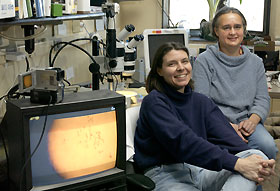Scientists’ Discovery Boosts
Understanding of Fertilization
 |
|
Lisa Mehlmann, left, assistant professor of cell biology, and Laurinda Jaffe, professor of cell biology at the Health Center, with a microscope view of immature egg cells called oocytes. |
|
Photo by Peter Morenus
|
Researchers at the Health Center have found a receptor that keeps eggs in “arrested development” in preparation for fertilization.
The arrest, or pause, is a crucial component of reproduction. The genetic code of human beings is contained within 46 chromosomes. Only half that number – 23 – exist within a sperm or egg cell; otherwise a fertilized egg would contain 92 chromosomes. Meiosis is the process that reduces the number of chromosomes in eggs in preparation for fertilization.
“In eggs, the process starts and stops; and it stays arrested in women for many years,” says Laurinda Jaffe, a professor of cell biology and one of the principal investigators on the project. “We were trying to determine the biochemical mechanisms that control the arrest.”
Understanding the process is particularly relevant to the process of in-vitro fertilization, according to Jaffe. “Right now in IVF, hormone injections are required to get the oocytes, as immature egg cells are called, to the right stage of maturation. It is a painful and expensive process. Once we fully understand the process of oocyte maturation, it may be possible to improve clinical methods for obtaining fertilizable eggs.”
Understanding this process may also be useful in the future development of contraceptives, says Jaffe: “If we knew more about what kept the oocytes from maturing to the point where they could be fertilized, that knowledge could be applied to possible new methods of contraception.”
Working with mice, Jaffe and colleague Lisa Mehlmann, an assistant professor of cell biology, located a receptor, called GPR3, that keeps the eggs arrested until the time for fertilization.
“Up to a certain point, oocytes don’t have the biochemical machinery they need to complete their maturation,” says Jaffe. “But even when the oocyte has reached full size, something in the ovary maintains its arrested state. We learned that it is the GPR3 receptor that maintains meiotic arrest, because if we eliminated the receptor protein then, even without hormonal stimulation, the oocyte proceeded with meiosis. The protein is essential for the arrested development.”
To understand whether the protein receptor has applications for humans, researchers have to determine whether humans have the same system.
“We have only looked at mice,” says Jaffe. “Given the similarities in biochemistry in both mouse and human oocytes, we think there are likely to be similarities in the maturation process in both species.”
The research was published in an article in the December issue of the journal Science.
For the complete text of the article, see “The Gs-Linked Receptor GPR3 Maintains Meiotic Arrest in Mammalian Oocytes,” Science, vol. 305 (December 2004) pp. 1947-50.

